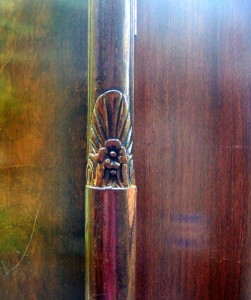 On Saturday morning, Berto Gonzales slept in, knowing that he should have the town car back to Elmendorf to Uncle Tony’s place by mid-day. He came yawning from the tiny back bedroom at his father’s place, drawn by the smell of bacon frying, coffee brewing, and the sound of the cable Univision channel on rather loudly. His grandmother, Adeliza Gonzales, had never learned English and was slightly deaf besides – but in spite of that and being relatively homebound at the age of 89, Adeliza Gonzales didn’t miss much, even though the only English-language programs she ever watched were on the Food Network. Berto’s father had bought a wide-screen television specifically to put in the kitchen so that Abuela Adeliza could watch her cooking shows in the comfort of the room that she loved the best.
On Saturday morning, Berto Gonzales slept in, knowing that he should have the town car back to Elmendorf to Uncle Tony’s place by mid-day. He came yawning from the tiny back bedroom at his father’s place, drawn by the smell of bacon frying, coffee brewing, and the sound of the cable Univision channel on rather loudly. His grandmother, Adeliza Gonzales, had never learned English and was slightly deaf besides – but in spite of that and being relatively homebound at the age of 89, Adeliza Gonzales didn’t miss much, even though the only English-language programs she ever watched were on the Food Network. Berto’s father had bought a wide-screen television specifically to put in the kitchen so that Abuela Adeliza could watch her cooking shows in the comfort of the room that she loved the best.
“Morning, Abuela,†Berto said, and then repeated himself slightly louder. Abuela Adeliza’s attention was riveted to the television screen, where an excited announcer was yammering on about … Berto wasn’t sure. It looked shaky cameraphone footage of a naked man with something metallic on his head, running down the street in a foreign city – a brief clip, then to steadier footage of an important-looking storefront building, with a large number of ambulances parked in front, flashing lights everywhere. Abuela Adeliza shook her head in dismay.
“Poor, poor fellow!†She exclaimed. “Such a shame … he had such a fine future before him … ‘morning, Berto; did you sleep well, then?â€
“Always,†Berto dropped a brief kiss on the top of Abuela Adeliza’s head. “Abuelita … may I have some migos and bacon? No one cooks migos like you do,†he added with calculation. Just as expected, Abela Adeliza rose from her rocking chair. The bacon was already cooked; a bowl of fresh-gathered eggs sat on the counter by the stove
“Of course, Berto,†she replied, but Berto’s attention was suddenly riveted by the television, all hunger forgotten. On the screen appeared a series of pictures – some of them intended for maximum dangerous glamor – of a youngish and rather handsome man in his thirties in a series of poses, alone or with others. In most of them, his head was covered by black and red plaid handkerchief tied do-rag fashion; his lower face adorned by carefully cultivated designer stubble; he held a knife, a cooking fork or a mixing bowl and whisk, standing in front of a truly ferocious stainless steel restaurant stove. The handkerchief seemed oddly familiar to Berto … and come to think of it, so did the young man’s features.
“Abuelita – who is he? That man – do you know him?â€
“Why, of course I do, Berto – it’s Rich Hall – they call him the Bad Boy Chef. He was coming up in the world, on television cooking shows so often… I thought he looked so much like your Abuelo Jesus when he was young – so dashing and handsome, so I always watched when he was on.â€
“Well, damn,†Berto exclaimed, “so he was a celebrity, after all! That’s the guy I picked up at Stinson last night. I practically don’t recognize him when he isn’t barfing or dead to the world.â€
“Oh, Berto!†Abuela Adeliza dropped the fork she had been scrambling eggs with. “Are you certain? But you must call Chief Vaughn at once, and tell him! Everyone is searching for him, pobrecito! He has disappeared!â€
“No, he hasn’t, Abuelita – I dropped him off at Hippie Hollow!â€
Abuela Adeliza assumed her sternest expression, commanding, “Berto – you will obey! You will call the police, at once.â€
“Why?†Berto was no longer eight years old, even if Abuela Adeliza still seemed to think so, sometimes. Abuela Adeliza told him. Before she was even finished, Berto had picked up the phone and dialed Joe Vaughn’s office.
“I swear to God, Jess,†Dr. Stephen Wyler examined the sludge at the bottom of his coffee mug, “if things don’t get better around here, I might as well stay home and poison myself with my own coffee.â€
“No, you old poop, you have too much fun, carrying on complaining,†Jess Abernathy replied, with a notable lack of sympathy.
“I’ll thank you to keep a civil tongue in your head, young woman,†Dr. Wyler replied, and Jess grinned at him. They were actually quite good friends, despite a distance of sixty years of age between them, Jess being a qualified CPA and Dr. Wyler one of her clients. As he was materially the wealthiest among them, Jess spent a good many hours untangling and keeping his complicated finances more or less in apple-pie order. There wasn’t much Jess didn’t know about Dr. Wyler. If no man was a hero to his valet, he most certainly isn’t to his CPA. Jess regarded him very much as a kind of honorary uncle, aside from the professional considerations.
“We might advertise for a replacement cook,†she suggested. “The Bee-Picayune has rather reasonable rates. I’ll call and see if they have room in next weeks’ classifieds.â€
“That’s how I got whats-his-name,†Dr. Wyler scowled. “And he left without notice as soon as he got a better offer from those bastards at Mills Farm … damn, is that your phone?â€
“No, it’s yours,†Jess replied. She and Dr. Wyler were sitting at one of the outside tables at the Luna Café and Coffee, enjoying the relative coolness of the morning, if not the currently dismal state of the Café’s menu selections.
“Damn fool invention …†Dr. Wyler unsnapped the catches of the ageing leather medical bag that accompanied him everywhere. He fished out the insistently buzzing cellphone from its depths and regarded it with mystification.
“Finger on the circle and slide over,†Jess hinted broadly.
“I knew that … Hello? Wyler here, what’s your major malfunction?… oh, hullo, Sefton.†Jess listened to the faint squawking emanating from Dr. Wyler’s phone. At last, he broke the connection. “Sorry, my dear – duty calls. Azúcar has developed a cyst on his neck which simply defies all of Judy’s home remedies.†Azúcar was the Grant’s pet snow-white llama, who because he had been bottle-fed since shortly after birth, had grown up to be almost two hundred pounds of bossiness with regard to humans.
“I’ll come with you,†Jess hastily stuffed her notebook, and took out some change for a tip, for the long-suffering high school girls who were tending tables during the summer. At ninety-four, Dr. Wyler was as wiry and weathered as a lifetime of riding, working cattle, and tending large recalcitrant animals could have made him, but still … ninety-four, against a two-hundred pound llama. Jess would have never forgiven herself if Dr. Wyler came to harm. “Heads or tails?â€
“Tails.â€
Jess deftly flipped the largest coin, caught it in her palm and slapped it down on the table.
“Heads, I drive, Dr. Wyler.â€
The Age of Aquarius Campground and Goat Farm was but a short distance away; it would have been little trouble for Jess to walk, but the day was already becoming warm, and mid-summers in South Texas are merciless to the elderly, no matter how hardened by a lifetime of work in it. Dr. Wyler’s late model extended-cab pickup truck with the custom design – the brand of the Lazy-W on the front doors – bumped down the unpaved ruts between the pasture where the Grants’ goat herd spent their days, and the smaller meadow scarred with regular tracks which – if you squinted and the light were somewhat dim – did somewhat resemble a campground. The only evidence of this for most of the year was the aged Airstream trailer with long-disintegrated tires parked at the top of the slope, under a fringe of trees farthest from the riverbank, as the solstice had been last month. The last of the mid-summer nudists had been gone for weeks and the campground reverted to its usual dilapidated appearance.
As Dr. Wyler’s truck came around the last bend, they both saw the single Luna City Police Department cruiser parked by the moldering Airstream, and Joe Vaughn – every crease of his crisp tan uniform short-sleeved summer uniform as sharp as if it had just came from the cleaners not ten minutes ago – leaning against the fender, deep in conversation with Sefton and Judy. In marked contrast, the Grants were not crisp in their attire. In point of fact, neither of them were attired, although in deference to local sensibilities, both had donned simple hand-loomed loincloths. It has long been a truism, and one deeply appreciated by Luna-ites that in just about every case, those who proudly and defiantly forswear clothing really ought not to indulge themselves this way, as a matter of aesthetics. Judy’s long hair covered the top half of her body rather efficiently, and Sefton wore battered cowboy boots.
“What’s going on, Chief?†Dr. Wyler spoke first. Joe Vaughn tilted his white felt Stetson a little farther back on his head and nodded politely to Judy. Joe was tall, hawk-faced with a direct gaze – also like a hawk – and very, very fit. A military tattoo with the motto “Death from Above†just barely showed below the bottom of his shirt sleeve, which barely constrained the arm that it clothed. His muscles had muscles.
“Welfare check on a guest,†Joe replied. “Berto Gonzales called me up, first thing this morning, with a tale of how he brought out a fare last night from San Antonio – and he saw him on the TV this morning. Miz Adeliza told him some cock and bull about the fare being some TV celebrity chef that went ‘round the bend. Just as soon as I put the phone down, Miz Grant calls and tells me that their guest from last night is nowhere to be found. His clothes, his bag and wallet are all here …â€
“And two empty bottles of Cristal,†Judy Grant put in, her pleasant round face the picture of worry. “I think he must have drunk it all… You don’t think he’s done away with himself, do you?â€
“Overpriced gnat-pee,†Dr. Wyler put in, apropos of nothing in particular. “A man with real taste wouldn’t swill anything but Krug for a last drink.â€
“Young Berto says his grandma told him this runaway chef is named Rich Hall,†Joe Vaughn answered. “But this joker’s Green Card and visa say that he is Richard Astor-Hall, and that he came in through New York two days ago. The paperwork says that he is a chef, though.â€
“You don’t say,†Dr. Wyler’s expression brightened … but just then, the screaming started.







